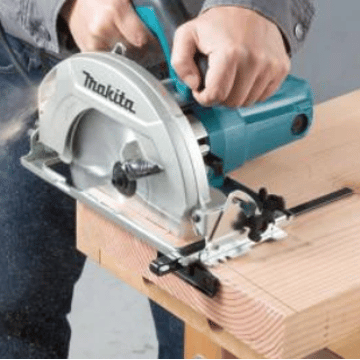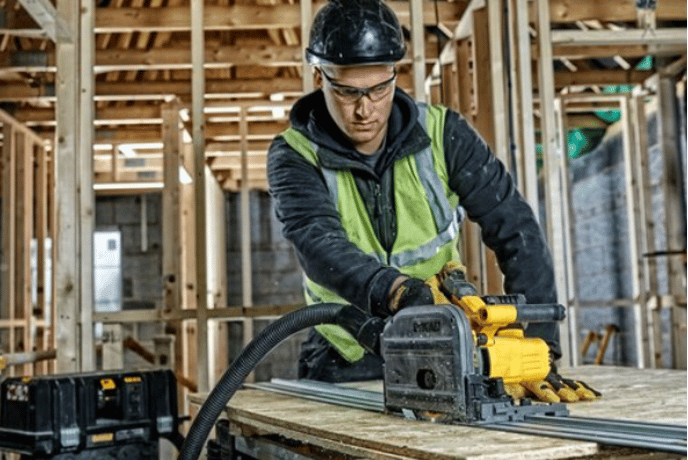Read Time: 6m 45s
Author: Aidan Mangan CEO Tool Equip
What’s the difference between a rail plunge saw and a normal circular saw?
- Introduction
- Why does this matter?
- Standard Circular Saws Mains Powered (110volt and 240volt) Pros & Cons
- Advantages of Standard Circular Saws (vs Plunge rails saws)
- Disadvantages of Standard Circular Saws (vs Plunge rails saws)
- Rail Plunge Saws (110 volt, 240volt & Cordless) Pros & Cons
- Advantages of Rail Plunge Saws (vs standard circular saws)
- Disadvantages of Rail Plunge Saws (vs standard circular saws)
- Summary
- Further Information
What’s the difference between a rail plunge saw and normal circular saw? This blog is not aimed for the DIY market. But people who use power tools as part of their daily work in Rep of Ireland. These are my own opinions based on over 30 years in the trade.
The last thing most tradesmen want to do, is waste money. We hope this Blog gives you the information you need, to pick the right one. Next time you’re buying one, you will have all the information you need.
People working in any area of the wood working trades such as floor layers, kitchen fitters, joineries, shop fitters and carpenters, will benefit from this information.
I will be dealing with the saws we stock. Which we’ve found are the most popular for our customers. Includes Festool and Dewalt rails saw vs Makita, Dewalt, Milwaukee & Hikoki standard Circular saws. Most of the information can relate to other brands too.
Why does buying the right saw matter ?
Over the years we’ve seen many a customer dissatisfied with a saw. Asking questions that tell us that the customer is not quite sure what the different saws were designed for. How they’re best used, or they’re trying to get a finish from the saw that it was never designed for. These tools aren’t cheap, so buying right first time saves money.


“Standard” Circular Saws Mains Powered (110volt and 240volt) Pros & Cons
These “standard” circular saws have been around for years. Available in most brands in both 240volt 3 pin plugs, and 110volt power for on site use. The most popular ones would be 7,8 & 9inch bladed models, with a greater depth cut as blade gets bigger.
Advantages of “Standard” Circular Saws (vs Plunge rail saws)
- Generally cheaper than Rail Saws.
- Also, there are some models that can be purchased with larger blades than rail plunge saws.
- Giving them a greater depth of cut, which can be very important for on site carpentry, roofing & fencing.
- So, blade depth can be locked on these saws, which is very handy in many applications.
Disadvantages of “Standard” Circular Saws (vs Plunge rail saws)
- Also, difficult to get a clean cut if working with laminates or delicate materials, even with a fine blade.
- Straight lines need to cut by eye, using pencil lines, unless you clamp up a straight edge.
- Finally, the open face on blade cover, means dust extractors don’t work well on these saws.
Rail Plunge Saws (110volt, 240volt & Cordless) Pros & Cons
These Rail Plunge Saws are available in most brands in 240volt, 110volt & Cordless options, but our most popular ones are Dewalt and Festool in both electric and cordless with 6” blades. In general the performance out of both electric and cordless rail plunge saws are similar, with electric versions cheaper, as you don’t have to purchase the batteries, but less convenient as you always have to have a power source beside you. If you already own compatible batteries however, the price of the saws are similar.
Advantages of Rail Plunge Saws (vs standard circular saws)
- Much better dust extraction when using a dust extractor with them, as the blade housing is completely enclosed trapping the dust so vacuum can extract well, ideal for indoor carpentry as well as cement fibre board cutting which creates a lot of cutting and dust issues.
- These saws give a much cleaner cut, due to the splinter guards on the underside of the rails, which act in the same way as a scoring blade on a panel saw, preventing chips appearing, making them ideal for all clean cut, fine finishing carpentry.
- Straight line cuts are much easier and more accurate with the rail, than following pencil lines and following by eye.
- Plunge cuts are possible and safer using the retractable riving knives on these saws, with some even having a new anti-kickback system.
- Saw moves smoothly on the rails, even with very rough timber, whereas standard saw bases can get snagged or caught on rough surfaces.
- Long cuts on sheet material can be stopped and re-started on exact same spot when using the rail, and if reaching across large sheets, you can even swap hands without affecting cut, as you are not following the line by eye, and don’t have to kneel up on sheets.
- Flush blade covers mean you can use the saw without rail pushed hard against the wall, ideal for cutting expansion joints in flooring, and can sometimes be turned on it’s side and the floor used as the fence to cut doors.
- Variable speed setting on them, makes them ideal for cutting a wide range of materials, such solid surface material, aluminium, die bond, plastics, grp, and cement fibre boards.
- Suction clamps are available for the Festool rails to allow safe cuts on some walls or doors already fitted.
- Festool in particular have a wide range of accessories that allow the saw to be used for special applications normally not possible with standard saws.
Disadvantages of Rail Plunge Saws (vs standard circular saws)
- The blade depth cannot be lock into position, making it hard to use one handed without the rail to guide it.
- Generally, the saws and the special type of blades they use, work out more expensive than standard saws.
- While there is an odd rail saw made with bigger blades, they tend to be specialised and very expensive, so most of these are designed for cuts max 50mm materials, so if you need to cut thicker than that, they might not be the best choice (although Festool do make an electric 70mm depth cut).
- If using 110volt power versions, and you are also using 110volt dust extractor with it, you will need to use a 5kva transformer to run them properly and prevent motor burn outs, due to power starvation that will happen if you use the smaller more popular 3 kva transformer, or generators of the same output.


In Summary
The “Standard” Circular Saw saws are more popular with customers who don’t need clean cuts and who sometimes need deeper cuts, making them ideal for doing a mix of jobs on building sites, such as cutting, roofs, fencing, shuttering, doors, flooring etc.
The “Rail Plunge Saws” tend to suit customers who clean accurate cuts, and where dust extraction may also be a bonus, making them ideal for kitchen fitters, cabinet makers, Wardrobe and bedroom furniture makers, 2nd fix site carpenters, floor layers, property maintenance, coach builders, shopfitters, sign writers etc.
Want more information ?
For details and prices of the standard circular saws we keep, please click below
https://toolequip.ie/product-category/power-tools/saws/?product-category=circular-saws
Learn more about Rail Plunge Saws
Video link on Festool Cordless Plunge Rail Saw, which we consider to be top of the range in the market right now.
https://www.youtube.com/watch?v=A2bbNZge02A&t=68s
——————————————————————————————————————————–
If you have any questions on tools in this article, or any others, please contact us on below link. (Only available to people based in Rep. of Ireland).
https://toolequip.ie/contact-us/
I hope you enjoyed this feature and thanks for reading it.
Aidan Mangan
Tool-Equip Ltd
Naas
Co. Kildare
Ireland
